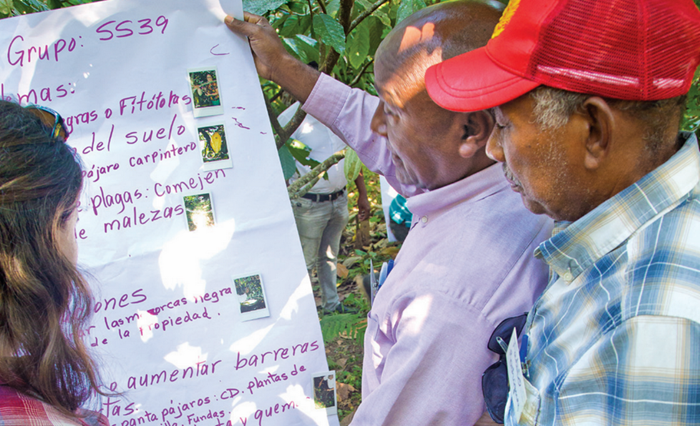CONACADO: Dominican cocoa producers strive towards excellence in production
In 2011, one of the biggest problems facing the Fairtrade cocoa cooperative CONACADO, based in the Dominican Republic, was the low productivity of its members.
On average, they were producing 436 kilos per hectare. But the yields of some farmers were as poor as 360 kilos per hectare. These figures were well below productivity levels in other cocoa-producing countries such as Brazil, Colombia or Peru.
There were a number of reasons they were doing badly: poor farm practises; the low density of cocoa plants combined with inadequate spatial distribution; limited financial resources to invest in farms and the use of low-productivity crop varieties.
The bad output figures were also producing wider, negative knock-on effects. A majority of CONACADO producers weren’t earning much and the younger members of the community didn’t see a future in cocoa production.
They needed to do something to improve the situation so they started, what they called, the Cooperative Development Program (CDP). Funded by the United States Agency for International Development (USAID) and supported by the Fairtrade export company, Equal Exchange, the project aimed to design a strategy to increase productivity, ensure better cocoa quality, and strengthen the capacities of the cooperative.
Demonstration plots: learn by observing best practices
One of the main interventions to increase cocoa productivity and quality involved setting up demonstration plots. Eight organic cocoa farms with very low levels of productivity were selected by CONACADO to serve as examples of good practice in cocoa management for other producers in the area.
Each demonstration plot was assigned a technician, who was in charge of the program. Using a process of constant training, they were responsible for implementing best practices with the producers who owned the plots.

The main objective of the project was to boost productivity and quality. © CONACADO
The project directly benefitted the producers who owned the plots and, indirectly, the 2,017 members of the relevant CONACADO branches. Through a combination of the demonstration plots and training, farmers were able to learn about and adopt appropriate agronomic practices. In addition, the plots also served as clonal gardens, where farmers could obtain vegetative material and seeds to produce grafted or hybrid plants for the renewal of their cocoa plantations.
Positive results
At the end of the project in 2017, productivity levels in both the demonstration plots and the plots located in the adjacent areas were calculated. The results showed a substantial improvement in productivity, demonstrating the effectiveness of the methods used. In the demonstration plots, productivity increased by 496 percent from 353 kg/ha at the beginning of the project in 2011 to 2,104 kg/ha in 2017. In areas close to the demonstration plots, productivity increased by 258 percent over the same period.
“When I started to apply the new practices to my plot […] people told me I was crazy, but I did it because I had seen that it gave results. My farm was previously very overgrown – it had old trees with low productivity. But I put in young plants and now those same people who told me I was crazy are interested in what I’m doing. The farm is 50 percent grafted with basal suckers and nursery grafts. Now the neighbours want to visit the farm because they have seen I have shade control, living barriers and a good level of production. They already say that I am not so crazy. In the other 50 percent of the farm I will continue to implement the new practices because they have made a difference. Now I can say that I am an expert in grafting.” Evaristo Sánchez, demonstration plot owner
Expanding the benefits
Following the successful completion of the project in 2017, CONACADO decided to invest part of its Fairtrade Premium in expanding the program to other branches and members of the cooperative. Currently, ten percent of CONACADO producers, or around 900 farmers, have direct access to demonstration plots where they can learn agricultural techniques and obtain vegetative material and seeds to renew their plantations. Already, they have seen an increase in productivity on their farms.
The Latin American and Caribbean Network of Fair Trade Small Producers and Workers (CLAC) has now decided to start a new phase of the project involving two other Fairtrade certified cooperatives in the Dominican Republic: COOPROAGRO and APCOC. Additionally, this new phase plans to involve cocoa producers from neighbouring Haiti, whose productivity rates are even lower. The objective is the transfer and exchange of technical knowledge, allowing Haitian producers to learn from Dominican producers.